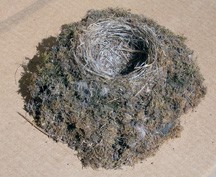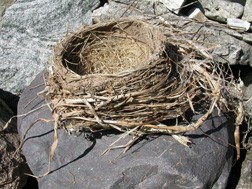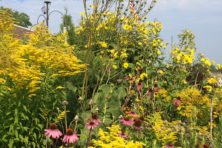Bird Nests
- Share
- Tweet
- Pin
- Share

The Eastern Phoebe’s nest contains a thick outer layer of moss. Photo by Roy Lukes.
Spring has sprung incredibly early this year; however, even under normal weather conditions, some bird nesting begins far earlier than many people realize – February in some years.
A good guess is that the Great-horned Owl is the first of the season to have eggs, laid in a nest built in previous years by, for example, a Red-tailed Hawk or American Crow. The hen owl often will be incubating her clutch of usually two eggs and may be covered with falling snow.
Those wonderful people who monitor bluebird nest boxes understand how soon after arriving in Door County these members of the thrush family can be building nests and laying eggs. The first nest in our trail of 36 nest boxes (within a six-square-mile area) was constructed by the female, with little to no help from the male, and completed on March 25. Five eggs were laid and being incubated by April 6. Yes, it was the extraordinarily warm March weather that triggered the earlier-than-normal nesting.
The first nest that captured my attention was when I was six or seven years old. It was built by a robin in the bend of the eave-trough pipe on the southwest corner of our house in Kewaunee. Robins, being so attracted to homes and mowed lawns, probably build the most-watched nests of all birds in our state.
At our house in the woods, robins have constructed nests in the lower branches of White Spruce trees each year, and once they even built a nest over 50 feet above the ground in a Sugar Maple tree in our front yard. Quite often, one of the two Eastern Phoebe nest shelves I’ve attached to the north side of our home – in the shelter of the over-hanging roof – or one to the shaded south side of our garage are claimed by robins nests.

A robin’s bulky nest has a thick mud base. Photo by Roy Lukes.
Nest building time often arrives during a very dry spell, just when birds need plenty of mud for construction, so I help create a little more mud. Two of the birdbaths in our front yard lie directly upon the ground, so as they are cleaned and refilled every morning, it is easy to pour an extra pail of water on the surrounding ground and grass. Both the robins and phoebes use this mud to fashion their exquisite nests, although more is used in the robin’s nest than in the phoebe’s.
When cleaning off the shelves at the end of the nesting season, I’ve carefully removed and photographed a few of them. Three of the phoebe nests, from three separate years, have been saved, and what fascinates me is that the birds used the very same species of moss in the outer layer of all three nests. I’m quite sure it’s one of the Dicranum (die-KRAY-num) species that often grows among the protruding roots and lower trunks of trees in cool, shady woods.
One of the most wonderfully built nests, downright artistic in its construction, is that of the Red-eyed Vireo, a common nester in our state. The nest is amazingly fastened and woven to hang downward from the narrow V-shaped crotch of a branch. Those we’ve observed most often include narrow strips of Paper Birch tree bark. Unfortunately, these nests are very heavily parasitized by the Brown-headed Cowbirds (which will be another story in the future).
When checking our bluebird nest boxes it is simple to know that a Tree Swallow has built its nest there because feathers, most often white, usually constitute the upper part of these nests. Where do they find the feathers? Frequently in spring, flocks of gulls, either Herring or Ring-billed, search for worms and grubs in freshly plowed fields, preening their plumage. Invariably they leave behind plenty of white feathers, some of which are gathered by the Tree Swallows and incorporated into their nests.

Thin strips of Paper Birch bark decorate the Red-eyed Vireo’s pendulous nest. Photo by Roy Lukes.
Have you ever discovered the nest of a Ruby-throated Hummingbird? Neither have I! I’ve been alerted to a few found by other people, who were able to locate them by carefully watching the female leave the sugar water feeder and fly away to her nest. (Male hummers never help build the nest or feed the babies.) The one nest I was able to collect had been built in a Sugar Maple tree close to the people’s screened porch. Hundreds of grade school students had the chance to carefully handle and marvel at that surprisingly flexible little nest, so small that an ordinary bottle cap could completely cover the top opening.
Professor John Thomson, world-famous lichenologist from the University of Wisconsin – Madison Botany Department, informed us that all of the several dozen Ruby-throated Hummingbird nests he examined at the Milwaukee Public Museum were decorated on their outer surfaces with the exact same species of lichen, the “Hammered Shield Lichen,” Parmelia sulcata. He was quick to add that this species of hummingbird was the world’s smallest lichen expert! This further reinforced our deep respect for the incredible nest-building skills of birds.
There are few families of birds that are as cosmopolitan as the swallows. They are known to many people of the world as being among the most maneuverable, graceful and agile of all birds. If you want to see and enjoy swallow habitat par excellence, spend a day at Rock Island State Park. The Cliff and the Barn Swallows have superb nesting and feeding sites in this pristine setting. You’ll be amazed at the swallow activity in the easily-accessible, large, ornate Icelandic boathouse, which is among the last remaining reliable nesting places for the sleek, fork-tailed Barn Swallows. Modern day farming increasingly uses tightly sealed and closed metal buildings that are generally impossible for the Barn and Cliff Swallows to enter. I fully sympathize with the farmers who surely don’t want their farm machinery thoroughly splattered with the chalky white-wash droppings of birds. Such are the signs of our times and progress.

Feathers surround the pale eggs in a Tree Swallow’s nest. Photo by Roy Lukes.
I recommend the excellent A Field Guide to Birds’ Nests, a Peterson field guide written and illustrated with fine colored photographs by Hal Harrison. And if by magic Edward Lear’s famous limerick could come true, I’d even grow a beard. Do you remember?
There was an old man with a beard,
Who said, “It is just as I feared!
Two owls and a hen,
Four larks and a wren,
Have all built their nests in my beard.”


